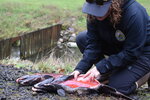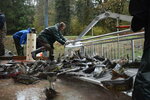

As temperatures drop and fall rains pick up, Grays Harbor's tributaries are seeing a rush of life as coho, chum and fall Chinook salmon make their way into the rivers and streams of their birth.
The returning salmon that began their lives as eggs in the streambed a few years earlier are among the doughty few with the chance to spawn in those same gravels and complete one of nature's most precarious and remarkable life cycles.
At the same time, people have a chance to witness the feat and learn more about the salmon's fight to survive and reproduce.
On Saturday, Nov. 4, a group gathered at Schafer State Park on the border of Grays Harbor and Mason counties as biologists detailed the spawning process taking place in the East Fork Satsop River rushing by a stone's throw away.
Unfortunately for the group, recent rains had swelled and dirtied the stream, acting as a veil to gravel nests — called redds — visible in the streambed a few days earlier. Kathy Jacobson, education and outreach coordinator with the Chehalis Basin Lead Entity, said on Saturday that hosts have considered shifting the annual salmon educational event to one week earlier as yearly weather patterns become more unpredictable.
Along with the Lead Entity, a broad group of organizations teamed up to host the event: the Grays Harbor Stream Team, Mason County Conservation District, Washington State Parks and the Washington Department of Fish and Wildlife.
One of their goals, Jacobson said, is to get the public "more informed about where we live, how precious it is where we live, and ways we can live more harmoniously."
"There's nothing like seeing salmon in the wild, and to be able to see this park where you can see their spawning behavior, it's profound," Jacobson said. "To be able to then spark that look back of 'okay, how can my love and appreciation for the resilience and strength of this fish, how can it translate to action items I can take?'"
Even though high water covered the redds, local WDFW biologist Lauren Bauernschmidt described the nests in detail. In an act of excavation, female salmon turn on their sides and use their tails as a shovel, digging a pit into which she deposits her eggs, and, with progressive shoveling, buries them under a mound of gravel.
The female might scour more than a dozen feet of gravel as she lays a succession of "egg pockets." While the gravel mound, called a tailspill, holds the eggs for up to three months away from predators, the excavated pit directly upstream slows and circulates the river's current, keeping the tailspill undisturbed and pushing the eggs — as well as the male's fertilizing sperm, when the time comes — toward the streambed.
Eggs might remain under the protection of the gravel for up to three months, said Curt Holt, a fish biologist with WDFW. During Saturday's salmon education event, Holt compared rain-induced high streamflow events for salmon as the equivalent to a tornado or hurricane ripping through a neighborhood.
Holt said each redd contains about 3,000 to 5,000 eggs in several different pockets. After emerging from the gravel and running a gauntlet of predators — other fish, otters and birds — to the ocean, only a handful will return to spawn as adults.
Bauernschmidt said anyone wading in local rivers this time of year should avoid stepping on the tailspill to ensure safety of the eggs. During lower water, redds are visible as large ovular scours on a streambed otherwise coated in algae.
As of early November the location of the redds at Schafer State Park is evident for another reason. As salmon return to the area, WDFW field biologists walk, boat, or in some cases fly in a helicopter to count the number of redds, and how the nests grow. Each redd is marked with multicolored flagging tied to overhanging branches on the river bank.
Fish biologists will then use the redd data to estimate the number of fish returning to the Chehalis River watershed this fall.
While attendees of Saturday's salmon event didn't witness salmon spawning at Schafer park, they did see hundreds of chum and coho salmon, clad in dark green and burgundy spawning colors, entering a spring-fed hatchery just upstream at the Satsop Springs Fish Hatchery, which is operated by the Chehalis Basin Fisheries Task Force through a grant from WDFW.
After passing through a series of wooden weirs, fish are corralled into a metal trough and lifted onto a concrete pad, where hatchery manager Steve Franks, along with about a dozen volunteers, toiled to bonk the salmon and slide their bright orange eggs into a bucket, which would then be used to spawn the next generation of fish genetically inclined to return to the hatchery.
After Franks cut open a female coho, exposing hundreds of orange orbs in her belly, Bauernschmidt used the carcass to teach visitors more about salmon anatomy, the reproductive process, and the signature differences between the chum salmon's menacing teeth and the coho's rounded snout.
Franks said some of the carcasses of fish returning to the hatchery are transported upstream and left to decompose. That's the final, though certainly not least important, step in the salmon life cycle, in which the rotting fish bodies release essential nutrients into the forest ecosystem around them.